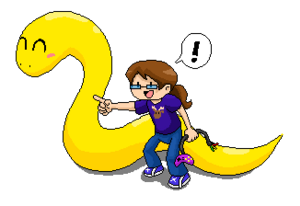PyGame Guide/Printable version

| This is the print version of PyGame Guide You won't see this message or any elements not part of the book's content when you print or preview this page. |
The current, editable version of this book is available in Wikibooks, the open-content textbooks collection, at
https://en.wikibooks.org/wiki/PyGame_Guide
Introduction
Hey there!
Hi! My name is Rachel. I'm a game developer and a teacher, and I'm here to teach you a bit about making 2D video games with Python and PyGame!
What is Python and PyGame?
Well, Python is a programming language and PyGame is a game development library.
Wait... what's a library??
Woah, one step at a time! We will go over game development terminology as well as basic concepts that you'll need to know for how a 2D game works -- How you place an image at a particular spot on the screen, how to know when two objects are touching, how to tell when a button is clicked, etc.
But, for now, let's just start off with introductions! This is only the first page of the tutorial and I've gotta get a few things out of the way!
OK, what's up?
Well, I should probably tell you who I am, how to contact me if you find an error in this document, the document's license, and... you konw, maybe my website in case you want to check out some games I've made.
Contact
editIF you have questions, comments, or fixes for this document, please feel free to email me at Rachel@Moosader.com !
License
editThis book is licensed under the CC-BY-SA 3.0 License license
This means that you can share the book with anyone, for any reason. Just make sure my name (and any other future contributors) show up in the text (that is, that we are attributed!)
About the author
editRachel Wil Sha Singh is a programmer/teacher/game developer from the Kansas City area. Rachel grew up in the Raytown, MO area and spent their tween and teen years learning to make video games - first with Visual Basic 5, then with C++, and learning lots of other things from there! Rachel's most popular tutorial is the YouTube-based series, "Beginner's Guide to Game Programming", made in 2008.
Rachel has worked as a web- and software-developer since 2010 after receiving their B.S. in Computer Science from UMKC. Rachel also runs a small startup called Moosader LLC.